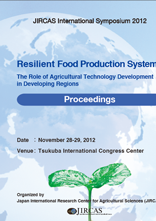Medium-And Long-Term Action against Drought in the Horn of Africa

The 2010/2011 drought in the Horn of Africa region was the worst in the last 60 years. It resulted in
severe humanitarian and food crisis affecting over 13 million people mostly from Somalia, Kenya and
Ethiopia. In Kenya, approximately 3.8 million people suffered from the drought mainly in the arid and
semi-arid lands (ASALs) where 95% of households are pastoralists or agro-pastoralists who rely on
livestock as the main source of livelihood.
The droughts in ASALs of Kenya have become longer and more frequent. As a result, for the last few
decades, the pastoralists have been regarded just as a target of humanitarian relief while 70% of livestock
is produced in the regions. Pastoralism remains the dominant and most economically rewarding activity.
We should recognize that the pastoralists have much potential to play a more significant role in Kenyan
economy.
Following the effects of the drought, there has been a strong commitment from the region and
international community to focus on interventions that will strengthen medium- and long-term resilience
to disasters. The Government of Kenya convened “Summit on the Horn of Africa Crisis” in September
2011 and compiled “Nairobi Strategy” which aims at ending drought emergencies through building
sustainable livelihood in the Horn of Africa.
Under this circumstance, the Japan International Cooperation Agency (JICA) commenced “the Project
for Enhancing Community Resilience against Drought (ECoRAD)” in Turkana and Marsabit counties in
northern Kenya with three years period from March 2012. The project aims at improvement of resilience
of pastoralists’ communities against drought with “Community-Managed Disaster Risk Reduction
(CMDRR)” approach and consists of four components; 1) Sustainable natural resource management, 2)
Improvement of livestock value chain, 3) Livelihood diversification, and 4) Capacity development.
CMDRR approach was developed by the International Institute of Rural Reconstruction (IIRR), which
aims at increasing group or community capacity in mitigating and preventing the impact of a hazard event,
building individual capacity to survive and bounce back, and strengthening the community as a functioning
support system, in line with “Hyogo Framework for Action” for disaster risk reduction.
In this presentation, the trend of international actions against the drought in the Horn of Africa and
Japan’s challenge for enhancing the resilience of pastoralists’ communities against drought in northern
Kenya through CMDRR approach will be reported.
| Date of issued | |
|---|---|
| Creator | Junichi Hanai |
| Subject |
Horn of Africa Drought Pastoralist Resilience Community-Managed Disaster Risk Reduction |
| Publisher | Japan International Research Center for Agricultural Sciences |
| Available Online | |
| Issue | 2012 |
| spage | 55 |
| epage | 67 |
| Rights | Japan International Research Center for Agricultural Sciences |
| Language | eng |
